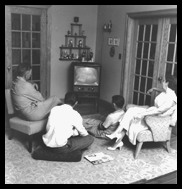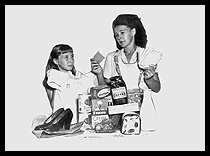 The postwar era, for public servants and general labourers alike, was
generally one of increased prosperity. Many working Canadians took the
opportunity to move to new homes in the suburbs, and to buy new appliances
and consumer goods. Not everyone, however, shared in the new-found wealth
and, during this period, many unions fought to ensure
a reasonable standard of living for all working Canadians.
The postwar era, for public servants and general labourers alike, was
generally one of increased prosperity. Many working Canadians took the
opportunity to move to new homes in the suburbs, and to buy new appliances
and consumer goods. Not everyone, however, shared in the new-found wealth
and, during this period, many unions fought to ensure
a reasonable standard of living for all working Canadians.
|
|
|

|
"Consumers were
apparently spending freely in the first half of 1953. Retail sales showed
an increase of 6.5% over the same period of 1952. With retail prices
slightly lower than in 1952, this means that people were buying a larger
quantity of goods than last year -- the percentage increase being more
than the percentage increase in population.
Thus the general indicators -- the overall level of employment, the
increase in industrial production, the increase in retail sales -- suggest
a fairly healthy situation in the economy."
Labor Facts, Vol. IV, No. 9, September 1953.
|

|
Why do unions feel
Canadians have a right to certain consumer goods?
|
|
 Pay cheque fails to meet food bills.
Price Campaign Propaganda
Pay cheque fails to meet food bills.
Price Campaign Propaganda
|
|
|
|

|
|